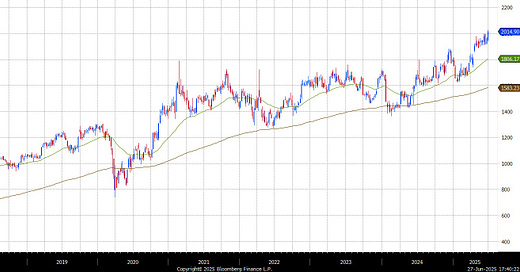India’s credit cycle is still expanding.
The oversubscribed IPO of HDB Financial Services is the 2nd biggest IPO for a non-bank in India’s history.
The company provides business loans, personal finance as well as car and gold loans.
When an IPO is 17 times oversubscribed it suggests a great deal of excitement at the prospect of the company making a great deal of cash.
For that to happen, India’s demand for credit will need to continue to trend higher.
The RBI is talking about continuing to cut interest rates following 100 basis points of cuts so far this year. That is good news for the property sector as well as for demand for credit.
In 2023 the RBI released a report discussing the length of the domestic credit cycle. Here is a summary of the report:
In this paper, Sujeesh Kumar, Pawan Kumar, and Anand Prakash examine the behaviour of credit, investment and business cycles in India during the period 1950-51 to 2020-21, employing the National Bureau of Economic Research (NBER) dating procedure. The study finds that the average duration of the business cycle and the investment cycle in India is eight years, while that of the credit cycle is seven years in case of short cycles. The average duration of the medium credit cycle in India (17 years) is higher than that of the investment cycle and business cycle, with the contractionary phases of the credit cycle found to be more prolonged than the expansionary phases.
The duration of the credit cycle has become longer since the initiation of financial sector reforms in the early-1990s. The paper finds bi-directional causality between credit cycle, investment cycle and business cycle, in the post-reforms period. The concordance index constructed in the paper shows that while phase synchronisation between investment cycle and the business cycle is 68 per cent, the synchronisation between the credit cycle and the investment cycle is 65 per cent. The results indicate an increase in synchronisation of the credit cycle in India with those of the emerging market economies as well as advanced economies after the global financial crisis.
India has historically performed independently of global markets. A large part of the reason for that was the domestic hostility towards foreign investment. The socialist isolationism insulated the market from global trends. That made for a strong argument for investing in India because it provides diversification for a portfolio.
The pressure to find jobs for several hundred million young people has forced the system to adjust. India is now moving progressively towards welcoming foreign direct investment, building infrastructure and manufacturing capacity. That is gradually aligning the credit cycle with the global norm. The strength of the expansion means the property cycle will also be lengthier and the stock market investment trend will be longer.
HDFC Bank and HDFC (mortgages) completed their merger in 2024. That created a dominant force in banking and mortgages which was an India equivalent of the US merger between JPMorgan and Chase.






